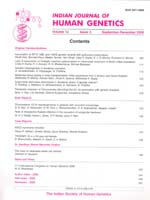
|
Indian Journal of Human Genetics
Medknow Publications on behalf of Indian Society of Human Genetics
ISSN: 0971-6866
EISSN: 0971-6866
Vol. 9, No. 2, 2003, pp. 40-50
|
 Bioline Code: hg03010
Bioline Code: hg03010
Full paper language: English
Document type: Research Article
Document available free of charge
|
|
|
Indian Journal of Human Genetics, Vol. 9, No. 2, 2003, pp. 40-50
| en |
Connexin 26 and autosomal recessive non-syndromic hearing loss
Monisha Mukherjee, S. R. Phadke, B. Mittal
Abstract
Prelingual deafness occurs with a frequency of 1 in 1000 live births and is divided into syndromic and non-syndromic forms contributing 40 and 60% respectively. Autosomal recessive non-syndromic hearing loss (ARNSHL) is responsible for 80% cases of childhood deafness. Nearly all genes localized for ARNSHL cause prelingual, severe to profound, sensorineural hearing impairment. ARNSHL is genetically heterogeneous and at least 39 loci have been identified. The most significant finding to date has been the discovery of mutations in GJB2 gene at the DFNB1 locus on chromosome 13q12 as the major cause of profound prelingual deafness. This was first reported in a Tunisian family in 1994 and thereafter in many different countries. GJB2 gene encodes the gap-junction protein, connexin 26 (Cx26), mutations in which have become the first genetic marker of inherited hearing loss. Allele-specific polymerase chain reaction (AS-PCR), single stranded conformation polymorphism (SSCP) and sequencing methods have been developed for the detection of mutations in Cx26 gene. In India as well, the Cx26 mutations are being screened in families with hearing impaired children using these molecular methods. Therefore, in order to create awareness among the clinicians and the affected families; we have attempted to review the Cx26 gene mutations responsible for autosomal recessive type of non-syndromic hearing loss. The efficacy and utility of Cx26 gene analysis might open the path to proper counseling of families for carrier detection and prenatal diagnosis. It may even facilitate the development of strategies in future for the treatment of this common genetic disorder.
Keywords
Non-syndromic, Hearing loss, Autosomal recessive, Connexin 26, DFNB1, mutation detection, Gap junction proteins, GJB2
|
| |
© Copyright 2003 - The Indian Society of Human Genetics
Alternative site location: http://www.ijhg.com/
|
|
